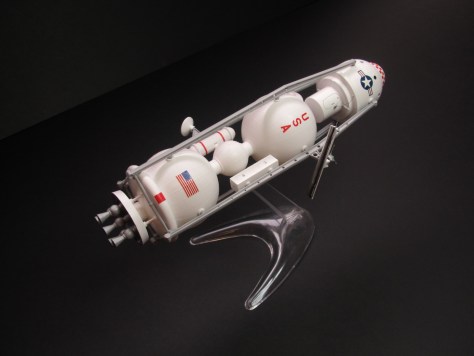 This is a rickety old kit, first issued in 1958 by Lindberg. The version I’m building is a nostalgic reissue by Round2. During its sixty-year history, it has undergone various metamorphoses: shifting its supposed scale between 1:96 and 1:200; changing its name from U.S. Moon Ship (1958) to Star Probe Space Shuttle (1980s) to Lunar Lander (1993) and then back to U.S. Moon Ship (2013); and being issued by at least three different companies—Lindberg, Glencoe and Round2.
This is a rickety old kit, first issued in 1958 by Lindberg. The version I’m building is a nostalgic reissue by Round2. During its sixty-year history, it has undergone various metamorphoses: shifting its supposed scale between 1:96 and 1:200; changing its name from U.S. Moon Ship (1958) to Star Probe Space Shuttle (1980s) to Lunar Lander (1993) and then back to U.S. Moon Ship (2013); and being issued by at least three different companies—Lindberg, Glencoe and Round2.

My interest stems from the fact it was based on a real design by Wernher von Braun, dating from the early 1950s, for a projected flight around the moon. A diagram of von Braun’s original conception appeared in the book Across The Space Frontier (1952), which I’ve previously reviewed. Von Braun’s plan involved assembling the 80-foot-long craft in orbit.

Chesley Bonestell produced a painting of the craft for a Collier’s magazine article published in March 1952, which was reproduced in Across The Space Frontier.

For reasons unknown, Lindberg decided to stick a set of landing legs on it, and to remove the crew access module from the personnel sphere, replacing it with an oddly sculpted but apparently functionless base. Even if this thing could land on the moon, the crew would be trapped in their quarters at the top of the stack, with no way to get out, let alone down to the surface.
Lindberg also added some strange red domes to cover the portholes, and discarded the hydrogen peroxide torus at the base of the stack.
So I wanted to migrate this lunatic Lindberg confection some way back towards von Braun’s original idea.
The first thing I did was chop the legs off.


Then I sawed the sculpted base off the personnel module, and replaced it with a scratch-built airlock, built from 20mm pipe and styrene card.

Finally (and miraculously) I discovered that two inches is a standard diameter for the sort of large curtain rings that slides along a pole, and that a two-inch ring fitted neatly into the base of the model framework. All I had to do was remove the eyelet from the ring, and I had my peroxide tank!


The strange red plastic domes were discarded, and the strange red plastic rocket nozzles were primed and painted.

Then it was just a matter of assembling the small number of parts, and shifting the kit’s single nitrogen tank slightly to accommodate the larger volume of the airlock. I discarded or repurposed most of Lindberg’s selection of decals, which didn’t seem to make much sense, and put together a set of markings from my decal stash that I felt fitted the period better—including a 48-star American flag and some late-war aircraft lettering.

It’s not a perfect reproduction of von Braun’s concept, but at least it has most of the right parts in approximately the right order.
I wanted to show the spacecraft “in flight”, and I wanted to have an astronaut performing some sort of EVA, as in Bonestell’s painting. So I found an old Airfix stand to attach the craft to, and I modified the legs of one of the kit’s standing astronaut figures to look more like someone working in free-fall. A length of 5-amp fuse wire (remember fuse wire?) provided the EVA tether.
Here’s the final result:







or

You must have a collection of numerous super models. I suppose in a lighted glass case. I’m impressed
Not quite in the same category, I started knitting another pair of socks !
Actually, the models hang around for a few years and then get chucked in the bin to make room for more. I enjoy the research and building much more than I enjoy looking at them, and in any case I keep a photographic record of them looking at their best, just after completion.
I’ll make an exception for the models I’m building of my late father’s aircraft from WWII – maybe a glass case eventually, once I see how much space they’re going to take up.